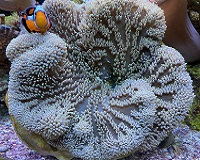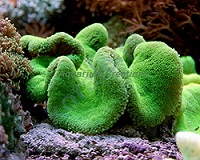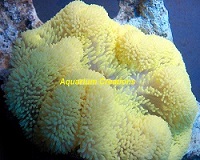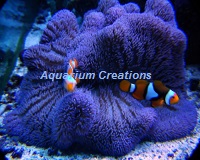
|
|
|
|
|
|
|
|
|
|
Gigantea Carpet Anemome For Sale
| Creation's sells Gigantea Carpet Anemone, Stichodactyla gigantea. They are also called the Giant Anemone, or the Giant Carpet Anemone. Incredibly fascinating marine life, they are one of the largest anemone's found in the Central Pacific, Indo Pacific, and the Red Sea. They can grow to about 3 feet in diameter and have a relatively large base. Like the Haddon's carpet, they also have short tentacles, but the tentacles typically are slightly longer than those of the Stichodactyla Haddoni, and are often slightly pointed at their tips. The Gigantea also have a much milder sting than the Haddon's. Differentiating the Gigantea from the Haddoni is best done by looking at the underside. The Haddon's have rows of spots on the underside of the oral disc which stop at the column, the Gigantea Carpet Anemone does not. |
| Cream Carpet Anemone Stichodactyla Gigantia starting at $69.99 |
Green Carpet Anemone Stichodactyla Gigantia starting at $189.99 |
Yellow Carpet Anemone Stichodactyla Gigantia starting at $149.99 |
Blue Carpet Anemone Stichodactyla Gigantia starting at $549.99 |
|---|---|---|---|
 |
 |
 |
 |
|
Tank Recommendations:
A 125 gallon or larger aquarium is highly recommended, and preferably one that has been running six months at the bare minimum. Carpet anemone need a large, stable, and established marine aquarium. Water parameters and temperature should remain rock steady at all times in order for long term success to be had.
Lighting Requirements: Although the blue spectrum is useful to pull out the beautiful colors, it is useless from a photosynthetic perspective. Carpet anemones house symbiotic algae (zooxanthellae) in their tissues, just like reef-dwelling corals do, and thus rely heavily on strong lighting in order to stay healthy. They don’t necessarily require a full-blown reef-lighting system with metal halide bulbs, but they do need at least a few high-output T5 flourescent bulbs over a small or medium system and add a few more t5's if its a larger aquarium. Lighting in the 5,500-10,000 kelvin temperature range is highly recommended for at least a portion of the day. Water Flow: Correct water flow is important for the anemone's long term success. Carpet anemone like random, turbulent water flow that is strong enough volume to lightly 'ruffle' the edges of the anemone. Stronger flow (especially laminar) would more than likely be to excessive and harm the anemone. Care must be taken with powerheads in saltwater aquariums containing anemones, as the anemone will be killed if caught by the pumps intake. Care also needs to be taken around overflows and similar areas should have their intakes covered with a sponge to prevent damaging the anemone if it went for a walk around the aquarium. Anemone Placement: The gigantea carpet anemone is typically found attached to something solid that’s buried in the sand such as a rock, or the bottom of the tank. Once in a while you may find one attached to hard substrates at the surface. I always suggest with carpet anemones, after lowering the water flow, dig a hole in the sand and place the base of the anemone in the hole. Next, place some sandy substrate around the column and increase the flow rate back to the normal output. Doing this will allow the anemone time to settle in and bury its foot completely into the sand bed. Finally place a piece of live rock directly next to it. Food and diet: Carpet anemone are carnivores, and a good meaty diet once or twice a week is all they ever should need. Experiment with different meaty foods to find out what and how much they’ll eat. Carpet anemone should be fed raw, minced meaty seafood items (shrimp, shellfish, fish, and krill to name a few, attained from your local grocery store), chopped to about 1/4 inches in size. Anemone do not have the capacity to "think" and will grab and attempt to ingest any meaty item that is fed to them, but do not mistake this as a reason to feed large pieces or whole animals (shrimp, fish), which will usually be regurgitated later and can possibly injure the animal internally. Level of Care: Advanced Aquarist Species, Advanced or Expert Aquarist Only, No Guaranteed Beyond Live Arrival. Keeping carpet anemones can be very difficult and should only be attempted by advanced marine aquarist, zoo, or marine research institutions. Putting an anemone in a new tank will result in failure. The tank should be at least 12 months old and stable before adding. More Information: Keeping this anemone requires great care in handling because it has a potent sting and is venomous. It is one of the few anemones that can cause some people to have a severe allergic reaction. Reef Compatibility :with caution Approximate Inflated Size: Small: 2" to 4" Medium: 4" to 6" Large: 6" to 8" XLarge: 8" to 11" |
|
|
|
|
|
|
|
|
|
|
|
Copyright 2020 Aquarium Creations Online Photos are representative of each species. Due to variations within species, your item may not look identical to the image provided. All marine life will be unique and variations should be expected, color and sizes may vary. |